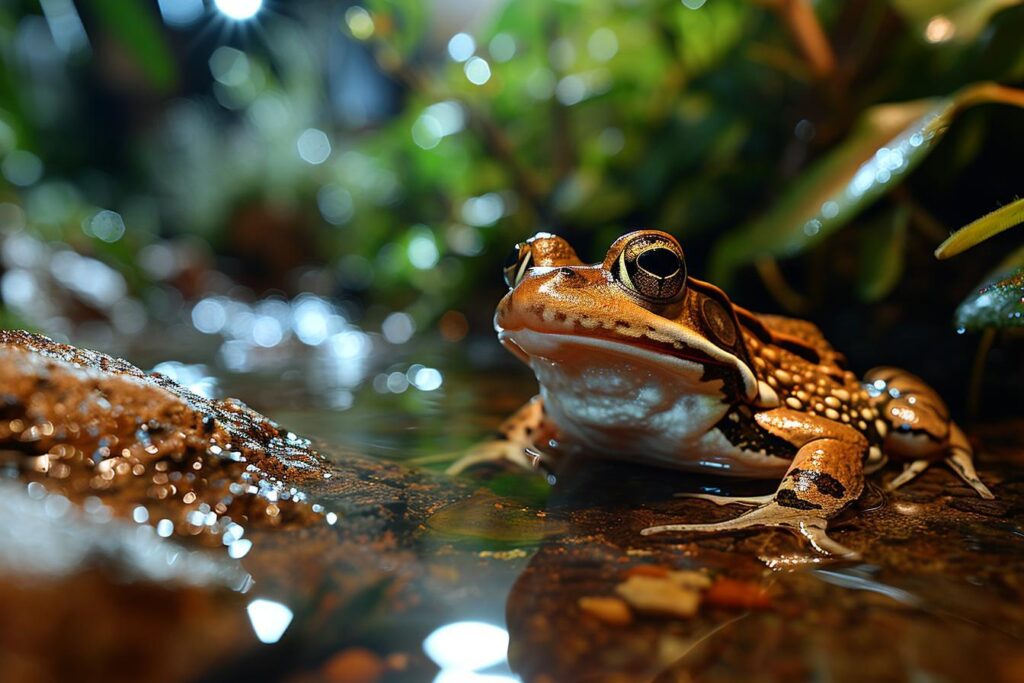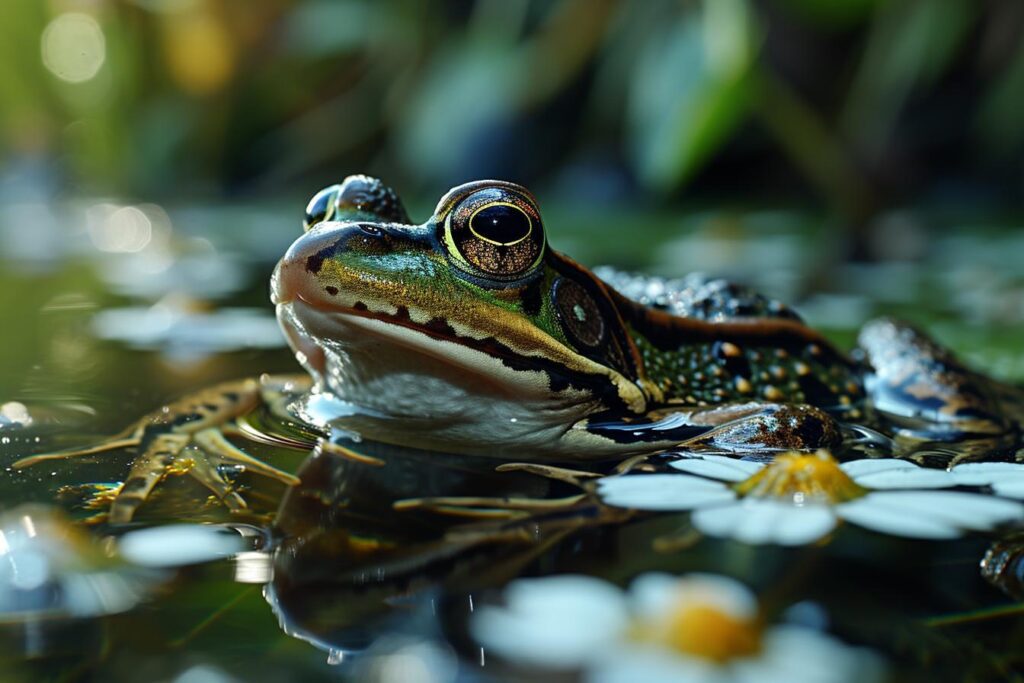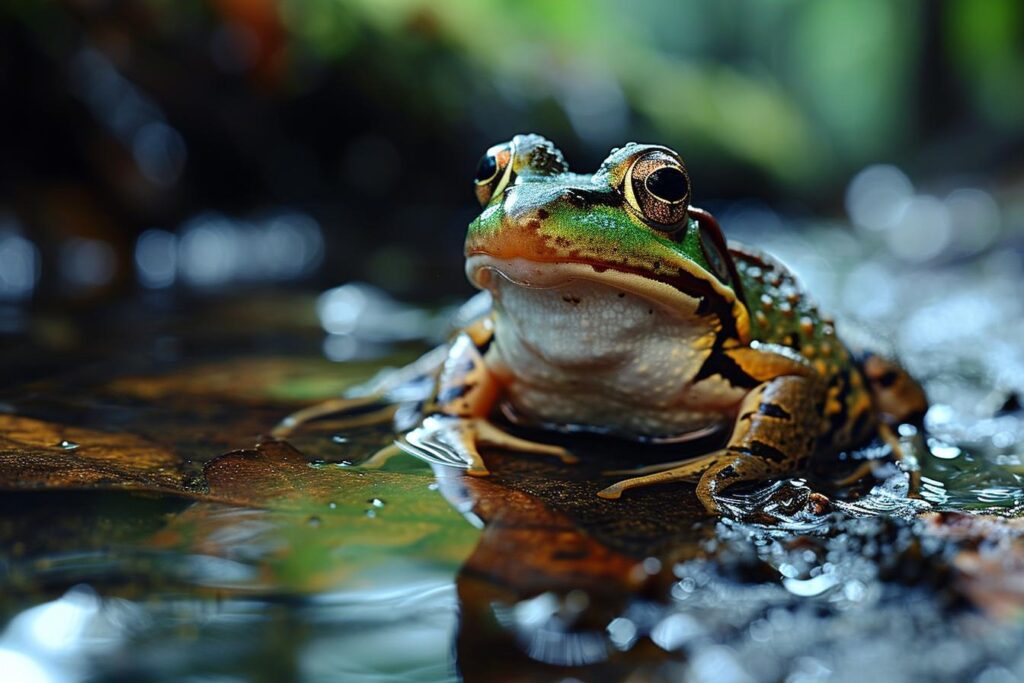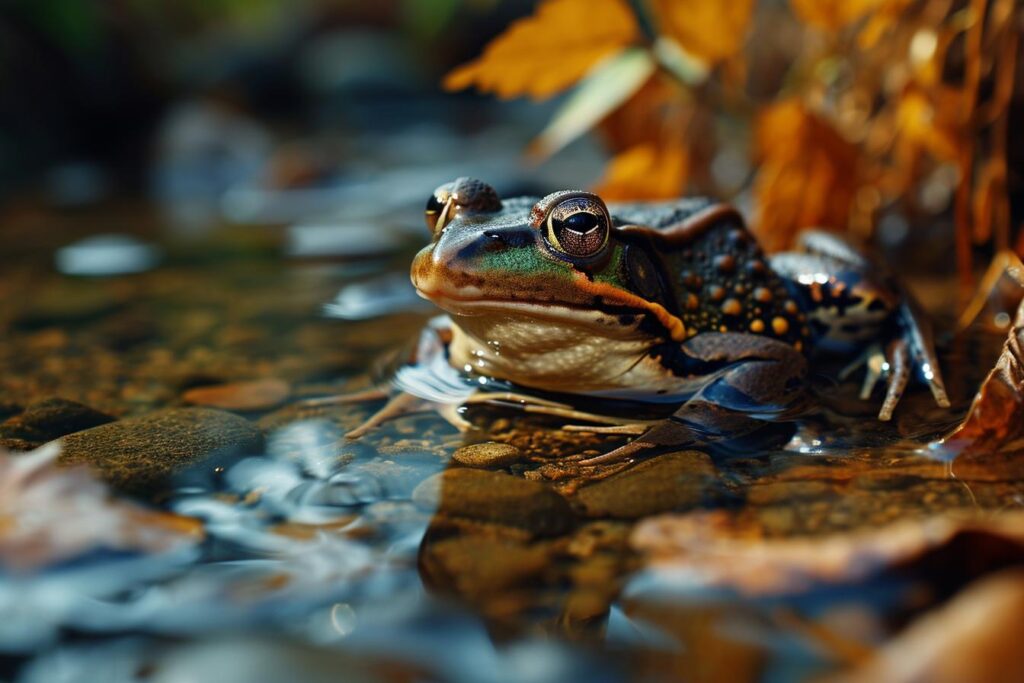If you have a pool in your backyard, you may have noticed frogs occasionally hopping in for a swim. While it may seem harmless to let them enjoy the water, you may be wondering how long they can survive in the chlorinated environment. The answer is not very long.
According to experts, frogs can generally only survive for a maximum of two days in a pool. This is due to the chlorine in the water, which can harm their skin and cause them to drown when they try to escape. Additionally, if a frog lays eggs in a pool with high levels of chlorine, the eggs are unlikely to hatch. While frogs in your pool may seem cute at first, it’s important to understand the potential health hazards they can pose.
So, what can you do if you find frogs in your pool? There are several methods for repelling or removing them, including using traps or poisons, covering the pool at night, and keeping the pool area clean and free of debris. By taking proactive measures to keep frogs out of your pool, you can ensure that both you and the frogs stay safe and healthy.

Understanding Frogs
Frogs are fascinating creatures that belong to the class Amphibia, which also includes salamanders and caecilians. These animals are known for their unique ability to breathe through their skin and their semi-aquatic lifestyle. There are over 7,000 species of frogs, and they come in a wide range of sizes, colors, and shapes.
When it comes to living in a pool, not all frog species are created equal. Some species are better adapted to living in water than others. For example, the American bullfrog is a common species that is often found in swimming pools. This species is known for its large size and ability to tolerate a wide range of environmental conditions.
Frogs reproduce through a process called external fertilization. This means that the male frog releases sperm into the water, and the female frog releases eggs. The eggs are then fertilized in the water, and tadpoles hatch from them. Tadpoles are the larval stage of frogs and are fully aquatic. They breathe through gills and feed on algae and other small organisms.
When it comes to living in a pool, frogs face a number of challenges. One of the biggest challenges is the presence of chlorine. Chlorine is a common chemical used to sanitize swimming pools, but it can be deadly to frogs. Exposure to high levels of chlorine can cause skin irritation, respiratory distress, and even death.
In addition to chlorine, frogs may also struggle to find food and suitable habitat in a swimming pool. Most swimming pools do not provide the type of environment that frogs need to survive. This means that even if a frog manages to survive for a short period of time in a pool, it is unlikely to thrive and reproduce.

Overall, while some frog species may be able to survive for a short period of time in a swimming pool, it is not a suitable habitat for these animals. If you want to protect the health and well-being of frogs in your area, it is important to take steps to prevent them from entering your pool.
Frog Habitats
Frogs are amphibians that can be found in a variety of habitats, ranging from ponds, lakes, rivers, swamps, wetlands, and even in your backyard. They are highly adaptable creatures that can survive in a wide range of environments, as long as they have access to water.
Frogs require a moist environment to survive, and they are most commonly found in areas with high humidity and wet areas. They are ectothermic, which means that they rely on external sources of heat to regulate their body temperature. This is why they are commonly found in areas with access to water, as it helps them regulate their body temperature.
Ponds, lakes, and rivers are some of the most common habitats for frogs. These bodies of water provide them with a consistent source of water, which is essential for their survival. They also provide them with access to food sources, such as insects and small animals.
Swamps and wetlands are also popular habitats for frogs. These areas are often characterized by high humidity and a variety of plant life, which provides them with shelter and food sources. They are also home to a variety of other amphibians and reptiles, which makes them a popular spot for breeding and reproduction.
Why Frogs Are Attracted to Pools
Frogs are attracted to pools for several reasons. Pools provide a cool and comfortable environment for frogs to live in, especially during hot weather. Frogs also need standing water to breed, and pools can provide an ideal breeding ground for them.
Another reason why frogs are attracted to pools is algae growth. Algae is a primary food source for many species of frogs, and pools with high levels of algae can be a prime spot for them to feed. Additionally, the chlorine in pool water can attract insects, which in turn can attract frogs looking for a meal.

If you have a water feature or a swimming pool, you may notice an increase in frog activity during the breeding season. Frogs will lay their eggs in freshwater, and if your pool is not treated with chlorine, it can become an attractive spot for them to breed.
It’s important to note that while frogs may seem harmless, they can actually pose a health risk to humans. Frogs can carry diseases such as salmonella, and their feces can contaminate pool water, leading to potential health problems.
Impact of Chlorine on Frogs
If you have a pool and you’re wondering how long a frog can live in it, it’s important to consider the impact of chlorine on these amphibians. Chlorine is a common chemical used to disinfect swimming pools and other water sources, but it can be toxic to aquatic life and frogs.
The toxicity of chlorine depends on its concentration. If the chlorine levels are too high, frogs will begin to experience respiratory problems and eventually die. On the other hand, low levels of chlorine can still be harmful to frogs over time.
It’s important to note that not all frogs are equally affected by chlorine. Some species are more sensitive than others, and young frogs are generally more vulnerable than adults. Additionally, high-chlorine water can be more toxic to frogs than chlorinated water that has been allowed to sit for a period of time.
If you want to keep frogs safe in your pool, there are a few things you can do. First, make sure your pool’s chlorine levels are within the recommended range. Second, avoid adding too much chlorine at once. Instead, add it gradually over time to prevent sudden spikes in concentration. Finally, consider using alternative methods for pool maintenance, such as a saltwater system or natural methods like plants and beneficial bacteria.
Dangers to Frogs in Pools
If you have a pool, you may have noticed that frogs like to hang out in and around it. While it may seem harmless to have these amphibians around, there are some dangers that you should be aware of. Here are some of the risks that frogs face when they come into contact with your pool:
- Drowning: Frogs are not natural swimmers, and they can easily drown if they fall into your pool and can’t find their way out. This is especially true if your pool has steep sides or lacks a shallow area where the frogs can rest.
- Chemicals: The chemicals used to keep your pool clean and clear can be harmful to frogs. Chlorine, for example, can cause skin rashes and other health problems for these creatures. If a frog ingests pool water, it can also suffer from internal damage or even die.
- Diseases: Frogs can carry a variety of diseases, some of which can be transmitted to humans. If a dead frog is left in your pool, it can contaminate the water and create a breeding ground for bacteria and diseases.
- Mortality: Even if a frog manages to survive in your pool for a while, it will likely have a shorter lifespan than it would in its natural habitat. This is because the pool may lack the food sources and other resources that the frog needs to thrive.
To protect frogs from these dangers, it’s important to take steps to keep them out of your pool. You can do this by installing a fence or other barrier around your pool, using a pool cover when the pool is not in use, and removing any dead frogs or other debris from the water as soon as possible. By being mindful of the risks that frogs face in and around your pool, you can help to protect these important creatures and ensure that they continue to thrive in the wild.
Frog Life Cycle in Pools
When it comes to the life cycle of a frog, pools can be a tricky place for them to survive. Here’s what you need to know about the different stages of a frog’s life cycle in a pool:
Frog Eggs
If a female frog lays eggs in a pool, the eggs usually won’t hatch due to the chlorine in the water. Even if they do hatch, the tadpoles that emerge will have a difficult time surviving in the pool.
Tadpoles
Tadpoles are the next stage in a frog’s life cycle. They breathe using gills and move like a fish. They use their long tails to swim and eat small water plants and algae. However, in a pool, they may not have access to enough suitable food sources to survive.
Frogs in Pools
Frogs that do make it to the adult stage in a pool may not live very long. They usually cannot survive more than two days in a pool at a maximum. They usually drown when they try to escape.

Frogs and Pool Maintenance
As a pool owner, you know that maintaining your pool is crucial to keeping it clean and safe for swimming. But did you know that pool maintenance also plays a role in keeping frogs out of your pool and ensuring their survival if they do happen to take a dip?
Here are some tips for keeping frogs out of your pool:
- Keep your pool clean and well-maintained. This includes regularly cleaning your pool with a pool skimmer and vacuum, and ensuring that your pool pump is working properly. A clean pool is less attractive to frogs, as they are less likely to find food or shelter in it.
- Use a pool cover. A pool cover can help keep frogs out of your pool, especially during the breeding season when they are more likely to lay eggs in your pool.
- Keep your pool chemicals balanced. While chlorine can be harmful to frogs, it is important to keep your pool chemicals balanced to prevent the growth of algae and other organisms that can attract frogs.
- Repair any leaks or cracks in your pool. Frogs are attracted to water, and even a small leak or crack can make your pool a more attractive habitat for them.
If you do find frogs in your pool, here are some steps you can take to ensure their survival:
- Remove them from the pool using a pool skimmer or net. Be gentle, as frogs can be easily injured.
- Release them into a nearby pond or other natural habitat. Avoid releasing them too close to your pool, as they may just hop back in.
- If you have tadpoles in your pool, remove them immediately. Tadpoles can quickly multiply and become a major nuisance.
By following these tips, you can help keep frogs out of your pool and ensure their survival if they do happen to take a dip. If you have any concerns about frogs in your pool or need help with pool maintenance, consider contacting a pool repairman for assistance.
Preventing Frogs in Pools
If you’re tired of finding frogs in your pool or worried about the potential health risks they pose, there are several steps you can take to prevent them from entering your pool in the first place.
1. Install a Fence
One of the most effective ways to keep frogs out of your pool is to install a fence around it. A fence can help prevent frogs from entering your pool area, and it also provides an added layer of safety for children and pets. Consider installing a chicken wire fence or a mesh fence that’s at least 4 feet high. Make sure the fence is secured to the ground to prevent frogs from burrowing underneath it.
2. Use a Pool Cover
Investing in a pool cover is another effective way to prevent frogs from entering your pool. A pool cover not only keeps frogs out, but it also helps keep your pool clean and reduces water evaporation. Make sure to choose a pool cover that fits your pool properly and is made of durable materials that can withstand the elements.
3. Use a Pool Net
A pool net is another option to keep frogs out of your pool. A net can be placed over the pool when it’s not in use, and it can be easily removed when you’re ready to swim. Make sure to choose a net that’s the right size for your pool and is made of durable materials that can withstand exposure to the sun and water.
4. Keep Your Pool Clean
Frogs are attracted to pools that are dirty and have algae growth. To prevent frogs from entering your pool, make sure to keep it clean and well-maintained. Use a pool skimmer to remove debris, and regularly test and balance the water chemistry to prevent algae growth.
By following these simple steps, you can prevent frogs from entering your pool and keep your pool clean and safe for swimming.
Natural Frog Repellents
If you’re looking for a natural way to keep frogs away from your pool, there are a few household ingredients and solutions you can use without harming them. Here are some common natural frog repellents:
- Citric acid: Citric acid is found in lemons and other citrus fruits. Spraying a solution of citric acid and water around your pool can help keep frogs away. Mix 1 cup of citric acid with 1 gallon of water and spray it around the perimeter of your pool.
- Coffee grounds: Coffee grounds can be used to repel frogs. Sprinkle used coffee grounds around the edges of your pool or in areas where you’ve seen frogs. The caffeine in the coffee grounds is toxic to frogs and can help keep them away.
- Vinegar: Vinegar is a natural frog repellent. Mix equal parts of white vinegar and water in a spray bottle and spray it around your pool. The strong smell of vinegar will help keep frogs away.
- Lemon juice: Lemon juice can be used to repel frogs. Mix 1 cup of lemon juice with 1 gallon of water and spray it around the perimeter of your pool. The strong smell of lemon juice will help keep frogs away.
- Frog repellent: There are also commercial frog repellents available on the market. These repellents are usually made with natural ingredients and are safe for the environment. Follow the instructions on the label for best results.
- Use vinegar: Vinegar can be used in a variety of ways to repel frogs. You can soak a cloth in vinegar and place it in areas where you’ve seen frogs, or you can spray a vinegar solution around the perimeter of your pool. The strong smell of vinegar will help keep frogs away.
Remember, it’s important to use natural frog repellents carefully and avoid harming the frogs. These solutions can help keep them away from your pool without causing any harm.
Frogs and Other Pool Inhabitants
When it comes to pool inhabitants, frogs are not the only creatures that you might find. There are several other bugs and insects that may be attracted to your pool. Some of these creatures are harmless, while others can be a nuisance or even harmful to humans. Here are some of the most common pool inhabitants that you might encounter:
- Bugs: Bugs are probably the most common pool inhabitants. They can include ants, mosquitoes, flies, beetles, and more. Most of these bugs are harmless and won’t cause any problems. However, mosquitoes can be a major problem, as they can carry diseases like West Nile virus and Zika virus.
- Spiders: Spiders are also common around pools. Most spiders are harmless and won’t cause any problems. However, some spiders, like black widows and brown recluses, can be dangerous if they bite you.
- Snails and Slugs: Snails and slugs are often attracted to pools, as they like to drink the water. While they are not harmful to humans, they can be a nuisance if they start to multiply and take over your pool.
When it comes to frogs, they can be a major health hazard if they are allowed to live in your pool. As we mentioned earlier, chlorine-rich water can be deadly to frogs, and they can drown if they are unable to escape the pool. If you have frogs in your pool, it’s important to remove them as soon as possible to prevent any health risks.
Impact of Frogs on Pool Water
When frogs jump into your pool, they can have an impact on the pool water. Here are some ways in which frogs can affect your pool water:
- Algae Growth: Frogs can contribute to the growth of algae in your pool. This is because they release waste into the water, which can provide nutrients for algae to grow. Algae can make your pool water cloudy and unappealing.
- Mosquitoes and Flies: Frogs are natural predators of mosquitoes and flies, which can be a nuisance around your pool. However, they can also attract these insects to your pool, which can be annoying for swimmers.
- Bacteria: Frogs can carry bacteria on their skin, which can be transferred to your pool water. This can potentially lead to infections or illnesses.
To minimize the impact of frogs on your pool water, you can take the following steps:
- Remove Frogs: If you find frogs in your pool, remove them as soon as possible. You can use a pool skimmer or net to scoop them out of the water.
- Maintain Chlorine Levels: Keeping the chlorine level in your pool within the recommended range can help to prevent the growth of algae and kill bacteria that may be introduced by frogs.
- Clean Your Pool Regularly: Regularly cleaning your pool can help to remove any waste or debris that may attract frogs or provide nutrients for algae to grow.
Frogs and Food Sources
It’s important to understand that different species of frogs have different dietary needs. However, most frogs are carnivorous and eat insects, worms, beetles, spiders, and other small creatures.
If you have a pool in your backyard, you may notice that frogs are attracted to it because of the abundance of bugs and insects that are drawn to the water. Frogs usually hang around their food sources, so if you want to discourage them from coming to your pool, you should try to reduce the number of bugs in your yard.
One effective way to do this is to remove any standing water from your property, as this can be a breeding ground for mosquitoes and other insects. You can also use bug zappers, citronella candles, or other insect repellents to keep bugs away from your pool area.
If you have a pet, you should be careful about leaving their food outside, as this can also attract frogs. Make sure to clean up any spilled food or water from your pet’s dish and store their food in a secure container.
Frequently Asked Questions
Is It Safe To Swim In A Pool With Frogs?
Swimming in a pool with frogs may not be safe. Frogs can carry diseases that can be harmful to humans, such as salmonella. Additionally, frogs may leave feces in the water, which can lead to contamination. If you do swim in a pool with frogs, it is recommended that you shower immediately afterward and avoid swallowing any pool water.
Can A Frog Survive In A Swimming Pool?
Frogs can survive in a swimming pool for a short period of time, but they will eventually drown if they cannot find a way to escape. Chlorine and other chemicals in the pool can also be harmful to frogs, and their eggs may not hatch in a chlorine-rich environment.
Should I Remove Frogs From My Pool?
If you have frogs in your pool, it is recommended that you remove them. Frogs can be a health hazard and may contaminate the water with feces or other bacteria. Additionally, if you have tadpoles in your pool, they can quickly multiply and become a nuisance.
What To Do If There Is A Frog In Your Pool?
If you find a frog in your pool, you can use a pool net to scoop it out and release it in a nearby pond or other body of water. Be sure to wear gloves to avoid direct contact with the frog, and wash your hands thoroughly afterward.
Can Frog Eggs Survive In A Pool?
Frog eggs are unlikely to survive in a pool, especially if the pool contains chlorine or other chemicals. If you do find frog eggs in your pool, it is recommended that you remove them immediately to prevent them from hatching and multiplying.
How Can I Prevent Frogs From Entering My Pool?
To prevent frogs from entering your pool, you can install a fence or other barrier around the pool area. You can also use a pool cover when the pool is not in use to prevent frogs from jumping in. Additionally, keeping the pool area clean and free of debris can help discourage frogs from entering the pool.
